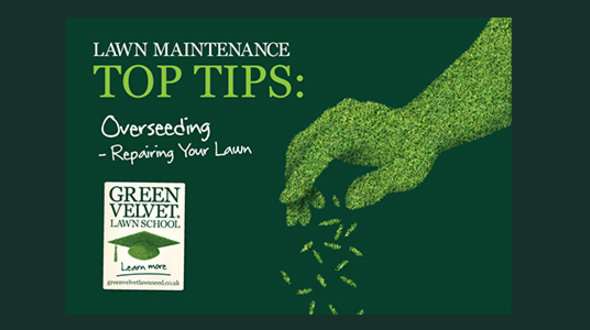THE BASICS
Sowing new seed into an existing lawn, a technique used by professional groundsmanagers is known as overseeding. Overseeding is a natural way to thicken your lawn and crowd out undesirable weeds, and one of the most important tasks involved in growing a healthy, lush lawn. Lawns that have not been overseeded will grow thin and unhealthy; making it much easier for weeds to overtake the lawn. It can be time-consuming if you have a large lawn, but it is not difficult, and the results are well worth the effort, dramatically improving the health and appearance of your lawn. It will also reduce weed invasion thus help to minimise the use of chemicals, which is both cost effective and environmentally friendly.
WHERE
If the lawn is looking in a poor condition, thinning/bare areas or you notice a lot of weeds in areas of the lawn.
WHEN
March to early May and early autumn – late August to September (the best time to overseed a lawn). Planting in late June and July should be avoided because of excessive heat and lack of moisture.
HOW…
THE STARTING POINT
- WEEDS. Remove weeds and debris from the area. If needed, kill off any weeds or moss a week or so before scarifying, preventing any new grass being killed by the weed killer.
- MOWING. Choose a time when the lawn is dry. Remove any rubbish from the surface and mow down as low as possible in order to minimise competition from existing grasses.
- DETHATCHING/SCARIFYING.Scarify or rake the thatch and grass clippings. A heavy layer of thatch (mostly dead organic matter on top of the soil) will prevent seeds, which need direct contact with the soil, from germinating and establishing properly.
- COMPACTION/AERATING. Aerating before you start seeding will help the seed get off to a good start, relieving compaction and waterlogging – one of the number 1 issues in most lawns.
- TOPDRESSING. Topdressing will help the seeds germinate and give the seedlings added nutrients with which to thrive. Lay a very thin layer of dressing over the entire surface of the lawn. Too little is better than too much. Too much and your existing grass will effectively be buried and die.
- SEEDING. It’s best to stay away from cheaper brands of seed. You really get what you pay for. Choose a seed mix that is compatible with your grass and with the climate in your area. Sow the seed in accordance with the instructions on the packet, either by hand or drop spreader.
- RAKING. After seeding rake lightly using a rake to help the seed make firm contact with the soil. You could also roll lightly or walk over the seeded area to press the seed into the soil. (Seed that does not come into direct contact with the soil will not germinate).
- FEEDING. Apply a balanced fertiliser before or after seeding to encourage the grass shoots to grow.
- WATERING. Grass seed needs moisture to germinate. Water the lawn immediately after overseeding. Continuing watering for the first few weeks to ensure proper germination and establishment.
- MOWING. Mow regularly but try not to remove more than a third of the growth at any one time. When grass is 5-8cms (2-3in) high cut for the first time. Trim lightly and very gradually lower blades to an ideal cutting height of 25mm (1in) for mixtures containing ryegrass and 13mm (½in) for non- ryegrass mixtures.


